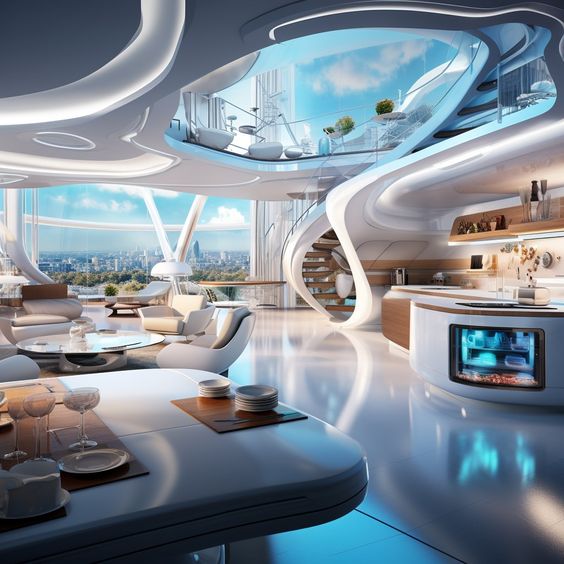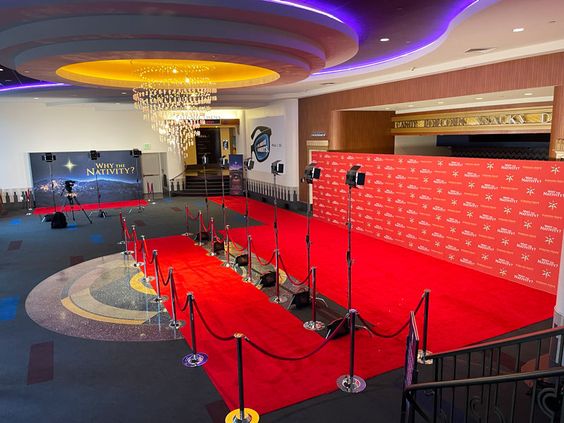The Intersection of Luxury and Technology in Modern Living

The intersection of luxury and technology in modern living represents a dynamic fusion that redefines the way we experience our homes. As technology continues to advance at a rapid pace, it has become increasingly integrated into the fabric of our daily lives, enhancing not only convenience but also elevating the concept of luxury to new heights.
Luxury living in the modern era is characterized by smart homes that are equipped with cutting-edge technology designed to streamline tasks and enhance comfort. From voice-activated assistants that control lighting and temperature to automated systems that manage security and entertainment, the possibilities for integrating technology into luxury homes are virtually endless.
Furthermore, luxury technology extends beyond mere functionality to encompass aesthetics and design. Sleek and minimalist devices seamlessly blend into the architecture of the home, creating an elegant and sophisticated ambiance that complements the overall luxuriousness of the living space.
Moreover, the allure of luxury technology lies in its ability to provide personalized experiences tailored to the preferences and lifestyle of the homeowner. Smart homes can learn and adapt to individual habits and routines, anticipating needs and preferences to create a truly customized living environment.
In essence, the intersection of luxury and technology in modern living represents a harmonious balance between innovation and elegance. As technology continues to evolve, so too will the possibilities for integrating luxury and convenience into our homes, creating living spaces that are not only technologically advanced but also inherently luxurious.
Evolution of Home Automation: From Convenience to Luxury
The evolution of home automation marks a journey from providing mere convenience to offering unparalleled luxury in modern living. Initially conceived as a means to simplify daily tasks and enhance efficiency, home automation has now transformed into a symbol of opulence and extravagance, redefining the concept of luxury within the realm of technology.
In its nascent stages, home automation primarily focused on automating routine household chores and functions, such as controlling lighting, temperature, and security systems. These early systems aimed to streamline tasks and improve convenience for homeowners, offering a glimpse into the potential of technology to enhance everyday living.
However, as technology advanced and became more sophisticated, the scope of home automation expanded to encompass a broader range of features and functionalities. Today, luxury home automation systems offer an array of cutting-edge features and amenities that go beyond mere convenience to provide an unparalleled level of comfort and luxury.
From integrated smart home ecosystems that allow for seamless control of multiple devices to personalized settings and preferences tailored to individual lifestyles, luxury home automation systems offer a level of customization and sophistication that was once unimaginable.
Moreover, the integration of luxury technology into home automation has elevated the aesthetics of smart homes, with sleek and minimalist designs that seamlessly blend into the architecture and interior decor. These advanced systems not only enhance the functionality of the home but also contribute to its overall elegance and sophistication.
In essence, the evolution of home automation from convenience to luxury reflects a broader trend towards integrating technology into every aspect of modern living, offering homeowners the ultimate in comfort, convenience, and opulence.
Smart Home Innovations: Enhancing Comfort and Convenience

Smart home innovations represent a revolutionary advancement in modern living, offering a plethora of technological solutions designed to enhance comfort and convenience for homeowners. These innovations have transformed the way we interact with our living spaces, providing seamless integration of technology into every aspect of daily life.
One of the key ways in which smart home innovations enhance comfort and convenience is through the integration of voice-activated assistants and virtual assistants. These intelligent systems, such as Amazon Alexa or Google Assistant, allow homeowners to control various aspects of their homes simply by speaking commands, from adjusting the thermostat to dimming the lights or playing music.
Moreover, smart home innovations extend beyond basic voice control to include sophisticated automation systems that can anticipate and respond to the needs and preferences of homeowners. For example, smart thermostats can learn users’ habits and adjust temperature settings accordingly, while automated lighting systems can create customized lighting schemes based on time of day or activity.
Furthermore, the advent of smart appliances and devices has further enhanced the comfort and convenience of modern homes. From smart refrigerators that can keep track of food inventory to intelligent security cameras that provide real-time monitoring of the home, these innovations offer homeowners unprecedented control and peace of mind.
In essence, smart home innovations represent a convergence of technology and luxury, providing homeowners with a level of comfort and convenience that was once unimaginable. By seamlessly integrating technology into every aspect of daily life, these innovations are transforming the way we live and interact with our homes, offering a glimpse into the future of modern living.
Designing with Technology: The Aesthetics of Smart Homes
In the realm of modern luxury living, the aesthetics of smart homes have evolved to seamlessly integrate technology into the design, creating spaces that are both visually stunning and technologically advanced. With advancements in smart home technology, homeowners now have the opportunity to incorporate cutting-edge devices and systems into their living spaces without compromising on style or elegance.
One way in which technology is integrated into the design of smart homes is through the use of sleek and minimalist devices that seamlessly blend into the architecture and interior decor. Gone are the days of bulky and unsightly gadgets; instead, smart home devices are now designed to complement the aesthetics of the home, with clean lines and modern finishes that enhance rather than detract from the overall design.
Moreover, smart home technology offers a range of customization options that allow homeowners to tailor the look and feel of their living spaces to their personal preferences. Whether it’s choosing the color and finish of smart light switches or selecting the style of smart thermostats, homeowners have the ability to design their smart homes to reflect their unique sense of style and taste.
Furthermore, the integration of technology into the design of smart homes extends beyond individual devices to encompass entire smart home ecosystems. From integrated lighting and sound systems to centralized control hubs, these advanced systems provide homeowners with seamless connectivity and control over every aspect of their living spaces.
In essence, designing with technology in smart homes is about creating spaces that are not only functional and efficient but also aesthetically pleasing and luxurious. By seamlessly integrating technology into the design, homeowners can enjoy the benefits of modern living without sacrificing style or elegance.
Security and Privacy in Smart Homes: Balancing Convenience with Protection
In the realm of smart homes, security and privacy are paramount concerns that must be carefully addressed to ensure the safety and well-being of homeowners. While the integration of technology into our living spaces offers unparalleled convenience and connectivity, it also raises important questions about the protection of sensitive information and the prevention of unauthorized access.
One of the key challenges in balancing convenience with protection in smart homes is the potential vulnerability of interconnected devices to cyber threats and hacking attempts. With an increasing number of devices connected to the internet, such as smart locks, security cameras, and thermostats, the risk of cyber attacks and privacy breaches becomes more significant. Therefore, it is essential for homeowners to implement robust security measures, such as strong passwords, encryption protocols, and regular software updates, to safeguard their smart home systems against potential threats.
Moreover, privacy concerns in smart homes extend beyond cyber threats to encompass issues such as data collection and surveillance. Many smart home devices collect and store data about users’ habits, preferences, and activities, raising concerns about how this information is used and protected. To address these concerns, homeowners should carefully review privacy policies and settings for smart home devices, opting for products that prioritize transparency and user control over data collection and sharing.
In essence, achieving a balance between convenience and protection in smart homes requires careful consideration of security and privacy implications at every stage of design and implementation. By prioritizing robust security measures and respecting user privacy rights, homeowners can enjoy the benefits of smart home technology without compromising on safety or peace of mind.
Energy Efficiency and Sustainability: The Eco-Friendly Aspect of Smart Living

In the realm of luxury living, the eco-friendly aspect of smart living has emerged as a prominent focus, with homeowners increasingly prioritizing energy efficiency and sustainability in their living spaces. Smart home technology plays a pivotal role in this endeavor, offering innovative solutions to reduce energy consumption, minimize environmental impact, and create more sustainable homes.
One of the key ways in which smart technology promotes energy efficiency in smart homes is through the use of smart appliances and devices that are designed to optimize energy usage. For example, smart thermostats can learn users’ habits and preferences to automatically adjust heating and cooling settings, resulting in significant energy savings over time. Similarly, smart lighting systems can be programmed to adjust brightness levels and turn off lights in unoccupied rooms, further reducing energy waste.
Moreover, smart home technology enables homeowners to monitor and manage their energy usage in real-time, providing insights into where energy is being consumed and opportunities for improvement. By empowering homeowners with this information, smart technology encourages more conscious energy consumption habits and promotes a culture of sustainability.
Furthermore, the integration of renewable energy sources, such as solar panels and wind turbines, into smart home systems further enhances their eco-friendly credentials. These clean energy solutions not only reduce reliance on fossil fuels but also contribute to a more sustainable and environmentally friendly way of living.
In essence, the eco-friendly aspect of smart living represents a convergence of technology and sustainability, offering homeowners the opportunity to reduce their environmental footprint while enjoying the comforts and conveniences of modern living. By embracing smart home technology, homeowners can contribute to a greener and more sustainable future while still indulging in the luxuries of modern living.
Personalized Experiences: Tailoring Smart Home Features to Individual Preferences
In the realm of luxury living, personalized experiences are at the forefront of smart home technology, allowing homeowners to tailor their living spaces to their individual preferences and lifestyles. Through the integration of advanced automation systems and customizable settings, smart homes offer a level of customization and control that is unparalleled, creating living spaces that are truly unique and tailored to the needs of each homeowner.
One of the key benefits of smart home technology is the ability to customize and automate various aspects of the home environment to suit individual preferences. From lighting and temperature control to entertainment and security systems, homeowners have the power to create personalized settings and schedules that align with their daily routines and preferences.
Moreover, smart home technology enables homeowners to create personalized experiences that extend beyond basic functionality to encompass a range of lifestyle preferences and interests. For example, smart home entertainment systems can be programmed to curate personalized playlists, recommend movies based on viewing history, and adjust audio and visual settings to create the perfect viewing experience.
Furthermore, the integration of artificial intelligence and machine learning algorithms into smart home systems allows for even greater personalization and customization. These advanced technologies can learn users’ habits and preferences over time, anticipating their needs and preferences to create more intuitive and seamless experiences.
In essence, personalized experiences in smart homes represent the pinnacle of luxury living, offering homeowners the opportunity to create living spaces that are as unique and individual as they are. By harnessing the power of smart home technology, homeowners can enjoy the ultimate in comfort, convenience, and luxury, tailored to their specific tastes and preferences.
Integration of Smart Home Devices: Creating Seamless Connectivity
In the realm of luxury living, the integration of smart home devices plays a pivotal role in creating seamless connectivity and enhancing the overall experience of homeowners. Smart home technology enables various devices and systems to communicate and work together harmoniously, creating a cohesive and interconnected ecosystem that simplifies everyday tasks and enhances convenience.
One of the key benefits of integrating smart home devices is the ability to control and manage multiple aspects of the home environment from a single interface. Whether it’s adjusting lighting, temperature, security settings, or entertainment systems, homeowners can easily control and monitor their smart home devices from their smartphone, tablet, or voice-activated assistant, creating a seamless and intuitive user experience.
Moreover, the integration of smart home devices allows for greater automation and efficiency in the home. For example, smart lighting systems can be synchronized with motion sensors and programmed to adjust brightness levels based on occupancy, while smart thermostats can communicate with weather forecasts and occupancy sensors to optimize heating and cooling settings for maximum comfort and energy savings.
Furthermore, the integration of smart home devices enables homeowners to create customized scenes and routines that automate various tasks and activities throughout the day. For example, a “good morning” scene could automatically adjust lighting, raise blinds, and start brewing coffee, while a “goodnight” routine could dim lights, lock doors, and arm security systems, creating a seamless transition between different times of day and activities.
In essence, the integration of smart home devices represents the pinnacle of luxury living, offering homeowners unparalleled convenience, efficiency, and connectivity. By creating a seamless and interconnected ecosystem of devices and systems, smart home technology enhances the overall living experience, transforming houses into intelligent and intuitive homes.
Future Trends in Smart Living: Anticipating Advancements in Luxury Home Technology
As technology continues to evolve at a rapid pace, the future of smart living holds immense promise for advancements in luxury home technology. From innovative new features and functionalities to cutting-edge design concepts, the future of smart living is poised to revolutionize the way we experience and interact with our living spaces.
One of the most anticipated trends in luxury home technology is the further integration of artificial intelligence (AI) and machine learning algorithms into smart home systems. These advanced technologies will enable smart homes to become even more intuitive and responsive, learning from user behavior and preferences to anticipate their needs and provide personalized experiences.
Moreover, the future of smart living is expected to bring about advancements in home automation systems that offer seamless connectivity and control over a wider range of devices and appliances. From automated kitchen appliances that can prepare meals to robotic assistants that can perform household chores, the possibilities for automation in luxury homes are virtually endless.
Furthermore, the future of smart living is likely to see advancements in energy efficiency and sustainability, with smart homes incorporating renewable energy sources, energy storage solutions, and smart grid technologies to reduce environmental impact and lower energy costs.
In essence, the future of smart living holds exciting prospects for advancements in luxury home technology, offering homeowners unprecedented levels of comfort, convenience, and connectivity. By embracing these future trends, homeowners can look forward to living in homes that are not only technologically advanced but also inherently luxurious, creating living spaces that are truly intelligent, intuitive, and inspiring.







